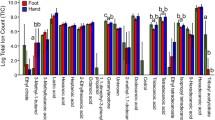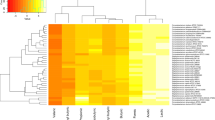Abstract
Human skin emanations attract hungry female mosquitoes toward their host for blood feeding. In this study, we report the flight orientation and electroantennogram response of Aedes albopictus females to certain unsaturated acids and alcohols found in human skin. In the Y-tube olfactometer, odors of lactic acid and 2-methyl-3-pentanol attracted 54–65 % of Ae. albopictus females at all doses in a dose-dependent manner. However, at the highest dose (10−2 g), the acids repelled 40–45 % females. Attractancy (ca. 62–68 %) at lower doses and repellency (ca. 30–45 %) at higher doses were recorded for 3-methyl-3-pentanol and 1-octen-3-ol, while 5-hexen-1-ol, cis-2-hexen-1-ol, and trans 2-hexen-1-ol odor repelled ca. 55–65 % of Ae. albopictus females at all doses. Antenna of female Ae. albopictus exhibited a dose-dependent EAG response up to 10−3 g of l-lactic acid, trans-2-methyl-2-pentenoic acid, 2-octenoic acid, trans-2-hexen-1-ol and 1-octen-3-ol stimulations; however, the highest dose (10−2 g) caused a little decline in the EAG response. EAG response of 9–10-fold was elicited by lactic acid, 2-octenoic acid, trans-2-hexenoic acid, and 3-methyl-3-pentanol, while cis-2-hexen-1-ol and trans-2-methyl pentenoic acid elicited 1–5-fold responses compared to solvent control. A blend of attractive compounds could be utilized in odor-baited trap for surveillance and repellent molecules with suitable formulation could be used to reduce the biting menace of mosquitoes.


Similar content being viewed by others
References
Acree FJ, Turner RB, Gouck HK, Beroza M, Smith N (1968) L-lactic acid: a mosquito attractant isolated from humans. Science 161:1346–1347
Bentley MD, Day JF (1989) Chemical ecology and behavioural aspects of mosquito oviposition. Ann Rev Entomol 34:401–421
Bernier UR, Kline DL, Barnard DR, Schreck CE, Yost RA (2000) Analysis of human skin emanations by gas chromatography/ mass spectrometry. 2. Identification of volatile compounds that are candidate attractants for the yellow fever mosquito (Aedes aegypti). Anal Chern 72:747–756
Bernier UR, Kline DL, Posey KH, Booth MM, Yost RA, Barnard DR (2003) Synergistic attraction of Aedes aegypti (L.) to binary blends of L-lactic acid and acetone, dichloromethane, or dimethyl disulfide. J Med Entomol 40:653–656
Bohbot JD, Durand NF, Vinyard BT, Dickens JC (2013) Functional development of the octenol response in Aedes aegypti. Front Physiol 4:1–8
Bosch OJ, Geier M, Boeckh J (2000) Contribution of fatty acids to olfactory host finding of female Aedes aegypti. Chem Senses 25:323–330
Cilek JE, Ikediobi CO, Hallmon CF, Johnson R, Onyeozili EN, Farah SM, Mazu T, Latinwo LM, Ayuk-Takem L, Berniers UR (2011) Semi-field evaluation of several novel alkenol analogs of 1-octen-3-ol as attractants to adult Aedes albopictus and Culex quinquefasciatus. J Am Mosq Control Assoc 27:256–262
Cilek JE, Ikediobi CO, Hallmon CF, Johnson R, Okungbowa O, Onyeozili EN, Khalil LM, Ayuk-Takem L, Latinwo LM, Bernier UR (2012) Evaluation of several novel alkynols, alkenols, and selected host odor blends as attractants to female Aedes albopictus and Culex quinquefasciatus. J Am Mosq Control Assoc 28:199–205
Cook JI, Majeed S, Ignell R, Pickett JA, Birkett MA, Logan JG (2011) Enantiomeric selectivity in behavioural and electrophysiological responses of Aedes aegypti and Culex quinquefasciatus mosquitoes. Bull Entomol Res 101:541–550
Cork A, Park KC (1996) Identification of electrophysiologically active compounds for the malaria mosquito, Anopheles gambiae, in human sweat extracts. Med Vet Entomol 10:269–276
Costantini C, Birkett MA, Gibson G, Ziesmann J, Sagnon NF, Mohammed HA, Coluzzi M, Pickett JA (2001) Electroantennogram and behavioural responses of the malaria vector Anopheles gambiae to human-specific sweat components. Med Vet Entomol 15:259–266
Dekker T, Steib B, Carde RT, Geier M (2002) L-lactic acid:a human-signifying host cue for the anthropophilic mosquito Anopheles gambiae. Med Vet Entomol 16:91–98
Dekker T, Geier M, Carde RT (2005) Carbon dioxide instantly sensitizes female yellow fever mosquitoes to human skin odours. J Exp Biol 208:2963–2972
Deng Y, Yan H, Gu J, Xu J, Wu K, Tu Z, James AA, Chen X (2013) Molecular and functional characterization of odorant-binding protein genes in an invasive vector mosquito, Aedes albopictus. PLoS One 8:e68836
Dormont L, Bessiere JM, Cohuet A (2013) Human skin volatiles: A review. J Chem Ecol 39:569–578
Geier M, Bosch OJ, Boeckh J (1999) Ammonia as an attractive component of host odour for the Yellow fever mosquito Aedes aegypti. Chem Senses 24:647–653
Guha L, Seenivasagan T, Bandyopadhyay P, Iqbal ST, Sathe M, Sharma P, Parashar BD, Kaushik MP (2012) Oviposition and flight orientation response of Aedes aegypti to aryl hydrazono esters. Parasitol Res 111:975–982
Hao H, Sun J, Dai J (2012) Preliminary analysis of several attractants and spatial repellents for the mosquito, Aedes albopictus using an olfactometer. J Insect Sci 12:76
Kawada H, Honda S, Takagi M (2007) Comparative laboratory study on the reaction of Aedes aegypti and Aedes albopictus to different attractive cues in a mosquito trap. J Med Entomol 44:427–432
Logan JG, Birkett MA, Clark SJ, Powers S, Seal NJ, Wadhams LJ, Mordue AJ, Pickett JA (2008) Identification of human-derived volatile chemicals that interfere with attraction of Aedes aegypti mosquitoes. J Chern Ecol 34:308–322
Logan JG, Pickett JA, Cameron MM (2013) Vector control using semiochemicals. In: Cameron MM, Lorenz LM (eds) Biological and Environmental Control of Disease Vectors. CAB International, London, pp 95–116
Mathew N, Ayyanar E, Shanmugavelu S, Muthuswamy K (2013) Mosquito attractant blends to trap host seeking Aedes aegypti. Parasitol Res 112:1305–1312
Puri SN, Mendki MJ, Sukumaran D, Ganesan K, Prakash S, Sekhar K (2006) Electroantennogram and behavioral responses of Culex quinquefasciatus (Diptera: Culicidae) Females to chemicals found in human skin emanations. J Med Ent 43:207–217
Reifenrath WG (2005) Natural insect repellent. Washington D.C.: U.S. Patent and Trademark Office, U.S. Patent No. 6,953,814.
Sastry SD, Buck KT, Janak J, Dressler M, Preti G (1980) Volatiles emitted by humans. In: Waller GR, Dermer OC (eds) Biochemical applications of mass spectrometry: First supplementary volume, vol 1. Wiley, Chichester, UK, pp 1085–1129
Schreck CE, Smith N, Carlson DA, Price GD, Haile D, Godwin DR (1981) A material isolated from human hands that attracts female mosquitoes. J Chern Ecol 8:429–438
Seenivasagan T, Vijayaraghavan R (2010) Oviposition pheromones in haematophagous insects. Vitam Horm 83:597–630
Seenivasagan T, Sharma KR, Sekhar K, Ganesan K, Prakash S, Vijayaraghavan R (2009a) Electroantennogram, flight orientation, and oviposition responses of Aedes aegypti to the oviposition pheromone n-heneicosane. Parasitol Res 104:827–833
Seenivasagan T, Sharma KR, Shrivastava A, Parashar BD, Pant SC, Prakash S (2009b) Surface morphology and morphometric analysis of sensilla of Asian tiger mosquito, Aedes albopictus (Skuse): an SEM investigation. J Vector Borne Dis 46:125–135
Seenivasagan T, Sharma KR, Ganesan K, Prakash S (2010) Electrophysiological, flight orientation and oviposition responses of three species of mosquito vectors to hexadecyl pentanoate: residual oviposition repellent activity. J Med Entomol 47:329–337
Seenivasagan T, Sharma KR, Prakash S (2012) Electroantennogram, flight orientation and oviposition responses of Anopheles stephensi and Aedes aegypti to a fatty acid ester-propyl octadecanoate. Acta Trop 124:54–61
Seenivasagan T, Guha L, Iqbal ST (2013) Behavioral and electrophysiological responses of Culex quinquefasciatus to certain fatty acid esters. Acta Trop 128:606–612
Seenivasagan T, Guha L, Parashar BD, Agrawal OP, Sukumaran D (2014) Olfaction in Asian tiger mosquito Aedes albopictus: flight orientation response to certain saturated carboxylic acids in human skin emanations. Parasitol Res 113:1927–1932
Sharma KR, Seenivasagan T, Rao AN, Ganesan K, Agrawal OP, Malhotra RC, Prakash S (2008) Oviposition responses of Aedes aegypti and Aedes albopictus to certain fatty acid esters. Parasitol Res 103:1065–1073
Sharma KR, Seenivasagan T, Rao AN, Ganesan K, Agrawal OP, Prakash S (2009) Mediation of oviposition responses in the malaria mosquito Anopheles stephensi Liston by certain fatty acid esters. Parasitol Res 104:281–286
Shirai Y, Kamimura K, Seki T, Morohashi M (2001) L-lactic acid as a mosquito (Diptera: Culicidae) repellent on human and mouse skin. J Med Entomol 38:51–54
Smallegange RC, Qiu YT, van Loon JJA, Takken W (2005) Synergism between ammonia, lactic acid and carboxylic acids as kairomones in the host-seeking behavior of the malaria mosquito Anopheles gambiae sensu stricto (Diptera: Culicidae). Chem Senses 30:145–152
Takken W (1991) The role of olfaction in host-seeking of mosquitoes: a review. Insect Sci Appl 12:287–295
Wang Z, Mo J, Zhang S (2006) Laboratory and field evaluations of potential human host odors for Aedes albopictus Skuse (Diptera: Culicidae). J Agric Urban Entomol 23:57–64
Acknowledgments
The work received financial grants through the Project-201 (S&T) of Defence Research and Development Establishment, Gwalior. The authors are thankful to the Director, Defence Research and Development Establishment, and Head, Vector Management Division, for their encouragement. We thank all the members of Vector management division for the help in maintenance of the mosquito culture. Lopamudra expresses her gratitude to Defence Research and Development Organisation, New Delhi, for the Junior Research Fellowship during the course of work.
Author information
Authors and Affiliations
Corresponding author
Rights and permissions
About this article
Cite this article
Guha, L., Seenivasagan, T., Iqbal, S.T. et al. Behavioral and electrophysiological responses of Aedes albopictus to certain acids and alcohols present in human skin emanations. Parasitol Res 113, 3781–3787 (2014). https://doi.org/10.1007/s00436-014-4044-0
Received:
Accepted:
Published:
Issue Date:
DOI: https://doi.org/10.1007/s00436-014-4044-0




